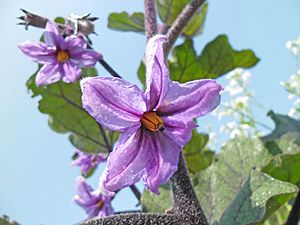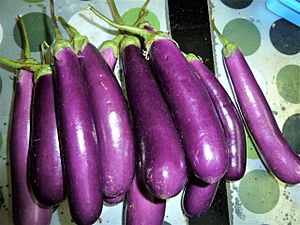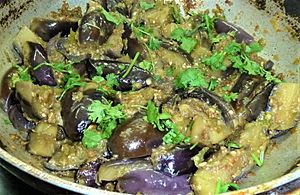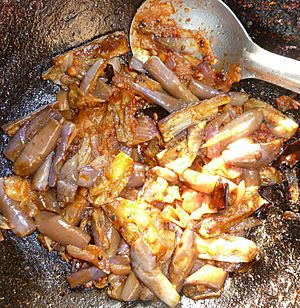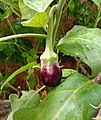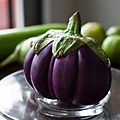Eggplant facts for kids
Quick facts for kids Eggplant |
|
|---|---|
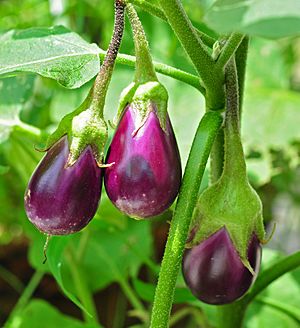 |
|
| Scientific classification | |
| Kingdom: | |
| (unranked): | |
| (unranked): | |
| (unranked): | |
| Order: | |
| Family: | |
| Genus: |
Solanum
|
| Species: |
S. melongena
|
| Binomial name | |
| Solanum melongena |
|
| Synonyms | |
|
Solanum ovigerum Dunal |
|
Eggplant (Solanum melongena) or aubergine is a species of nightshade grown for its edible fruit. Eggplant is the common name in North America, Australia and New Zealand; in British English, it is aubergine, and in South Asia and South Africa, brinjal.
The fruit is widely used in cooking. As a member of the genus Solanum, it is related to the tomato and the potato. It was originally domesticated from the wild nightshade species, the thorn or bitter apple, S. incanum, probably with two independent domestications, one in South Asia and one in East Asia.
Contents
Description
The eggplant is a delicate, tropical perennial often cultivated as a tender or half-hardy annual in temperate climates. The stem is often spiny. The flower is white to purple, with a five-lobed corolla and yellow stamens. The egg-shaped, glossy, purple fruit has white flesh with a meaty texture. The cut surface of the flesh rapidly turns brown when the fruit is cut open.
It grows 40 to 150 cm (1.3 to 4.9 ft) tall, with large, coarsely lobed leaves that are 10 to 20 cm (3.9 to 7.9 in) long and 5 to 10 cm (2.0 to 3.9 in) broad. Semiwild types can grow much larger, to 225 cm (7.38 ft) with large leaves over 30 cm (12 in) long and 15 cm (5.9 in) broad. On wild plants, the fruit is less than 3 cm (1.2 in) in diameter, but much larger in cultivated forms: 30 cm (12 in) or more in length.
Botanically classified as a berry, the fruit contains numerous small, soft seeds that, though edible, taste bitter because they contain nicotinoid alkaloids like the related tobacco.
History
The plant species originated in cultivation. It has been cultivated in southern and eastern Asia since prehistory. The first known written record of the plant is found in Qimin Yaoshu, an ancient Chinese agricultural treatise completed in 544. The numerous Arabic and North African names for it, along with the lack of the ancient Greek and Roman names, indicate it was introduced throughout the Mediterranean area by the Arabs in the early Middle Ages. A book on agriculture by Ibn Al-Awwam in 12th-century Arabic Spain described how to grow aubergines. Records exist from later medieval Catalan and Spanish.
The aubergine is unrecorded in England until the 16th century. An English botany book in 1597 stated:
This plant groweth in Egypt almost everywhere... bringing forth fruit of the bigness of a great cucumber.... We have had the same in our London gardens, where it hath borne flowers, but the winter approaching before the time of ripening, it perished: nothwithstanding it came to bear fruit of the bigness of a goose egg one extraordinary temperate year... but never to the full ripeness.
Because of the plant's relationship with various other nightshades, the fruit was at one time believed to be extremely poisonous. The flowers and leaves can be poisonous if consumed in large quantities due to the presence of solanine.
The eggplant has a special place in folklore. In 13th-century Italian traditional folklore, the eggplant can cause insanity. In 19th-century Egypt, insanity was said to be "more common and more violent" when the eggplant is in season in the summer.
Cultivars

Different cultivars of the plant produce fruit of different size, shape, and color, though typically purple. The most widely cultivated varieties—cultivars—in Europe and North America today are elongated ovoid, 12–25 centimetres (4+1⁄2–10 in) long and 6–9 cm (2+1⁄2–3+1⁄2 in) broad with a dark purple skin.
A much wider range of shapes, sizes, and colors is grown in India and elsewhere in Asia. Larger cultivars weighing up to a kilogram (2.2 pounds) grow in the region between the Ganges and Yamuna Rivers, while smaller ones are found elsewhere. Colors vary from white to yellow or green, as well as reddish-purple and dark purple. Some cultivars have a color gradient—white at the stem, to bright pink, deep purple or even black. Green or purple cultivars with white striping also exist. Chinese cultivars are commonly shaped like a narrower, slightly pendulous cucumber. Also, Asian cultivars of Japanese breeding are grown.
- Oval or elongated oval-shaped and black-skinned cultivars include 'Harris Special Hibush', 'Burpee Hybrid', 'Bringal Bloom', 'Black Magic', 'Classic', 'Dusky', and 'Black Beauty'.
- Slim cultivars in purple-black skin include 'Little Fingers', 'Ichiban', 'Pingtung Long', and 'Tycoon'
- In green skin, 'Louisiana Long Green' and 'Thai (Long) Green'
- In white skin, 'Dourga'.
- Traditional, white-skinned, egg-shaped cultivars include 'Casper' and 'Easter Egg'.
- Bicolored cultivars with color gradient include 'Rosa Bianca', 'Violetta di Firenze', 'Bianca Sfumata di Rosa' (heirloom), and 'Prosperosa' (heirloom).
- Bicolored cultivars with striping include 'Listada de Gandia' and 'Udumalapet'.
- In some parts of India, miniature cultivars, most commonly called vengan, are popular.
Varieties
- S. m. var. esculentum – common aubergine, including white varieties, with many cultivars
- S. m. var. depressum – dwarf aubergine
- S. m. var. serpentium – snake aubergine
Genetically engineered aubergine
Bt brinjal is a transgenic aubergine that contains a gene from the soil bacterium Bacillus thuringiensis. This variety was designed to give the plant resistance to lepidopteran insects such as the brinjal fruit and shoot borer (Leucinodes orbonalis) and fruit borer (Helicoverpa armigera).
On 9 February 2010, the Environment Ministry of India imposed a moratorium on the cultivation of Bt brinjal after protests against regulatory approval of cultivated Bt brinjal in 2009, stating the moratorium would last "for as long as it is needed to establish public trust and confidence". This decision was deemed controversial, as it deviated from previous practices with other genetically modified crops in India. Bt brinjal was approved for commercial cultivation in Bangaladesh in 2013.
Cooking and preparing
The raw fruit can have a somewhat bitter taste, or even an astringent quality, but becomes tender when cooked and develops a rich, complex flavor. The fruit is capable of absorbing large amounts of cooking fats and sauces, making for very rich dishes, but salting reduces the amount of oil absorbed. Many recipes advise salting, rinsing, and draining the sliced fruit (a process known as "degorging") to soften it and to reduce the amount of fat absorbed during cooking, but mainly to remove the bitterness of the earlier cultivars. Some modern cultivars—including large purple ones commonly imported into western Europe—do not need this treatment.
Eggplant is used in the cuisines of many countries. Due to its texture and bulk, it is sometimes used as a meat substitute in vegan and vegetarian cuisines. The fruit flesh is smooth, as in the related tomato. The numerous seeds are soft and edible along with the rest of the fruit. The thin skin is also edible.
East Asia
Korean and Japanese eggplant varieties are typically thin-skinned.
In Chinese cuisine, eggplants are known as qiézi (茄子). They are often deep fried and made into dishes such as yúxiāng-qiézi (fish fragrance eggplants).
In Korean cuisine, eggplants are known as gaji (가지). They are steamed, stir-fried, or pan-fried and eaten as banchan (side dishes), such as namul, bokkeum, and jeon.
-
Chinese yúxiāng-qiézi (fish-fragrance eggplants)
South Asia
Eggplant is widely used in its native India, for example in sambar (a tamarind lentil stew), dalma (a dal preparation with vegetables, native to Odisha), chutney, curry, and achaar (a pickled dish). Owing to its versatile nature and wide use in both everyday and festive Indian food, it is often described as the "king of vegetables". Roasted, skinned, mashed, mixed with onions, tomatoes, and spices, and then slow cooked gives the South Asian dish baingan bharta or gojju, similar to salată de vinete in Romania. Another version of the dish, begun-pora (eggplant charred or burnt), is very popular in Bangladesh and the east Indian states of Odisha and West Bengal where the pulp of the vegetable is mixed with raw chopped shallot, green chilies, salt, fresh coriander, and mustard oil. Sometimes fried tomatoes and deep-fried potatoes are also added, creating a dish called begun bhorta. In a dish from Maharashtra called bharli vangi, small brinjals are stuffed with ground coconut, peanuts, onions, tamarind, jaggery and masala spices, and then cooked in oil.
Middle East and the Mediterranean
Eggplant is often stewed, as in the French ratatouille. Eggplant is also often deep fried as in the Italian parmigiana di melanzane, the Turkish karnıyarık, or Turkish and Greek musakka/moussaka, and Middle Eastern and South Asian dishes. Eggplants can also be battered before deep-frying and served with a sauce made of tahini and tamarind. In Iranian cuisine, it is blended with whey as kashk e bademjan, tomatoes as mirza ghassemi, or made into stew as khoresh-e-bademjan. It can be sliced and deep-fried, then served with plain yogurt (optionally topped with a tomato and garlic sauce), such as in the Turkish dish patlıcan kızartması (meaning fried aubergines), or without yogurt, as in patlıcan şakşuka. Perhaps the best-known Turkish eggplant dishes are imam bayıldı (vegetarian) and karnıyarık (with minced meat).
It may also be roasted in its skin until charred, so the pulp can be removed and blended with other ingredients, such as lemon, tahini, and garlic, as in the Arab baba ghanoush and the similar Greek melitzanosalata. A mix of roasted eggplant, roasted red peppers, chopped onions, tomatoes, mushrooms, carrots, celery, and spices is called zacuscă in Romania, and ajvar or pinjur in the Balkans.
A Spanish dish called escalivada in Catalonia calls for strips of roasted aubergine, sweet pepper, onion, and tomato. In Andalusia, eggplant is mostly cooked thinly sliced, deep-fried in olive oil and served hot with honey (berenjenas a la Cordobesa). In the La Mancha region of central Spain, a small eggplant is pickled in vinegar, paprika, olive oil, and red peppers. The result is berenjena of Almagro, Ciudad Real.
A Levantine specialty is makdous, another pickling of eggplants, stuffed with red peppers and walnuts in olive oil.
Eggplant can be hollowed out and stuffed with meat, rice, or other fillings, and then baked. In the Caucasus, for example, it is fried and stuffed with walnut paste to make nigvziani badrijani.
Production
In 2016, global production of eggplants was 51.3 million tonnes. That year, almost 1.8 million hectares (4.4 million acres) were devoted to the cultivation of eggplants in the world. Over 62% of that output came from China alone. India (24.5% of world total), Egypt, Turkey, and Iran were also major producers.
Images for kids
-
Philippine tortang talong, an eggplant omelette made from grilled skinned eggplants
-
Philippine rellenong talong, a variant of tortang talong stuffed with ground meat and various vegetables
See also
 In Spanish: Solanum melongena para niños
In Spanish: Solanum melongena para niños


